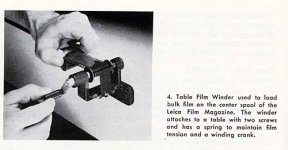The AFLOO was meant to be used in the darkroom, in total darkness. It should be used on a workbench. It is fixed to a table by means of screws. The film spool is placed between the spindles. After turning out the lights, the end of the film is taped on or inserted in the spool slot. By counting the turns of the crank, the number of exposures per load can be made. Usually it takes 30 to 32 turns to make a 36 exposure load.
I believe that you could use both FILCA and ordinary plastic spools from factory cassettes since the two are almost the same in dimensions. With plastic spools, you'd have to fix the film ends with tape.
I think the AFLOO was designed to be used with shorter film supplies. There used to be pre-notched (film is notched at the portions to mark the 1,6m length needed) in short lengths which had enough to make four 36-exposure loads. Shorter lengths can be left to curl on the other side whilst being reeled and cut for individual spools.
For longer lengths, a spindle for holding the supply roll should be made at the other end of the table. The arrangement would be similar to a film-editing moviola layout where film is spooled by reels on each end.
Loading in the dark may sound so difficult to do, but the AFLOO, according to the Leica book from which the attachment below was copied, saved loaders from the trouble of working with pins 1,6m spaced apart on long tables to mark and score film lengths in the dark.


